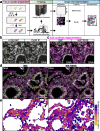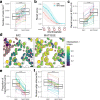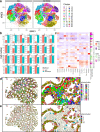MATISSE: a method for improved single cell segmentation in imaging mass cytometry
- PMID: 33975602
- PMCID: PMC8114487
- DOI: 10.1186/s12915-021-01043-y
MATISSE: a method for improved single cell segmentation in imaging mass cytometry
Erratum in
-
Publisher Correction to: MATISSE: a method for improved single cell segmentation in imaging mass cytometry.BMC Biol. 2021 Jun 18;19(1):125. doi: 10.1186/s12915-021-01065-6. BMC Biol. 2021. PMID: 34144713 Free PMC article. No abstract available.
Abstract
Background: Visualizing and quantifying cellular heterogeneity is of central importance to study tissue complexity, development, and physiology and has a vital role in understanding pathologies. Mass spectrometry-based methods including imaging mass cytometry (IMC) have in recent years emerged as powerful approaches for assessing cellular heterogeneity in tissues. IMC is an innovative multiplex imaging method that combines imaging using up to 40 metal conjugated antibodies and provides distributions of protein markers in tissues with a resolution of 1 μm2 area. However, resolving the output signals of individual cells within the tissue sample, i.e., single cell segmentation, remains challenging. To address this problem, we developed MATISSE (iMaging mAss cyTometry mIcroscopy Single cell SegmEntation), a method that combines high-resolution fluorescence microscopy with the multiplex capability of IMC into a single workflow to achieve improved segmentation over the current state-of-the-art.
Results: MATISSE results in improved quality and quantity of segmented cells when compared to IMC-only segmentation in sections of heterogeneous tissues. Additionally, MATISSE enables more complete and accurate identification of epithelial cells, fibroblasts, and infiltrating immune cells in densely packed cellular areas in tissue sections. MATISSE has been designed based on commonly used open-access tools and regular fluorescence microscopy, allowing easy implementation by labs using multiplex IMC into their analysis methods.
Conclusion: MATISSE allows segmentation of densely packed cellular areas and provides a qualitative and quantitative improvement when compared to IMC-based segmentation. We expect that implementing MATISSE into tissue section analysis pipelines will yield improved cell segmentation and enable more accurate analysis of the tissue microenvironment in epithelial tissue pathologies, such as autoimmunity and cancer.
Keywords: Colorectal tissue; Imaging mass cytometry; Immune histochemistry; Microscopy; Single cell segmentation.
Conflict of interest statement
The authors have no competing interests to declare
Figures



References
Publication types
MeSH terms
Substances
Grants and funding
LinkOut - more resources
Full Text Sources
Other Literature Sources
Medical
Molecular Biology Databases

